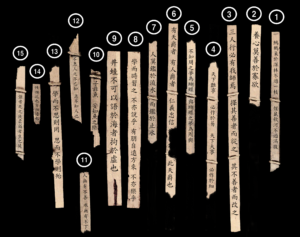Erwin Miyasaka: Encountering Classical Chinese Philosophy Through Translation and a Text Adventure
Over winter break I usually spend a good deal of time with my nephew, codename Loke, now 11 years-old. Over the past few years, I have hidden a bonus Christmas present somewhere for him and developed a puzzle that reveals its location. I began with a cryptography puzzle that involved decrypting a message using a double transposition cipher for which the key was supplied. The second year’s puzzle was called “The Bestiary” and involved chasing down references to lots of monsters in various literary traditions and using their names to spell the location of the prize.

The inspiration for the second part of the puzzle, the text adventure game, was partly self-serving. Over the winter break I wanted to spend some time learning the programming language Python after years away from occasional tinkering with Ruby and PHP in grad school. I always think the best way to do something like this is to have a concrete and achievable project, so this time my concrete project was a game for Loke. The code ended up a total mess to look at (I didn’t have a good understanding of how classes worked in Python and thus didn’t really know why things worked when they did), but it was lots of fun to recreate that nice 1980s text adventure feeling. There are a number of open source starter kits out there to help you create a text adventure game in Python. I used the lovely bwx-adventure Python module created and used by a school in San Francisco called SF Brightworks to help children create their own adventure. I then made a few tiny modifications to the code so that the module and game would run online in a browser through Trinket.
When Loke finished his fifteen translations, I gave him a web link to his game. His goal, essentially, is to explore the game and hunt down his fifteen quotes within it on signs, scrolls, and rock carvings found in the locations of the game. When he finds a match, he makes a note of a letter found with each quote. If he can find his way past various challenges to a special “machine room,” guarded by a tomb demon, he can input the code into the machine and it will spit out the location of his prize in the real world.
Loke has, as of this posting, explored about half the game, and identified about half of his translated quotes (along with a few misidentifications, which I hope he will spot when he finds the proper matches). As with puzzles in previous years, he has moments of excitement and enthusiasm for the puzzle, after which he puts it down only to return days, weeks, or months later. I was certainly no different at his age, and I can’t pretend my text adventure can compare to the lure of his joys in Minecraft (I decided not to develop the game in Minecraft, despite lots of great options for this, partly because I don’t think he would not be able to resist the urge to beautify the horribly newb work of his ancient uncle).
As he explores the game Loke is encountering lots of other quotes from the Chinese classics (citations for the translations used can be access by typing “about” in the game or also here), and while wandering through the domains of Kongzi (Confucius), Mengzi (Mencius), Zhuangzi, and Loazi, he has the opportunity to meet and talk to a range of interesting characters in addition to the main four, including but not limited to Mengzi’s mother, Ban Zhao, Mozi, Huizi, the Robber Zhi in monkey form (who will steal your stuff), a giant tortoise, a cook named Meng Shen, Jesus (who can be found hanging out with the Daoists), and a frog (take a stab at where it can be found).
I have created a generic version of the game so that anyone can play. You can also modify the final victory message, or otherwise modify the code either directly on trinket, or via the code repository at github. The full presentation of the game, including a link to the bamboo slips and glossary can be played here:
================ The Hall of Sages Adventure Game ================
Ver fuente
Comments
Post a Comment